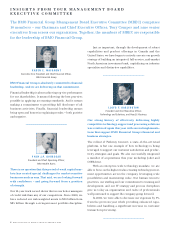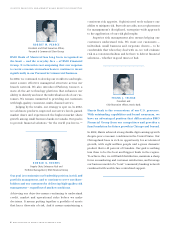Bank of Montreal 2002 Annual Report Download - page 18
Download and view the complete annual report
Please find page 18 of the 2002 Bank of Montreal annual report below. You can navigate through the pages in the report by either clicking on the pages listed below, or by using the keyword search tool below to find specific information within the annual report.
14 BMO FINANCIAL GROUP ANNUAL REPORT
2002
CANADIAN AND NORTH AMERICAN
PEER GROUP COMPARISONS
2002 2001 Five-Year Average
Cdn. N.A. Cdn. N.A. Cdn. N.A.
BMO Rank bank bank BMO Rank bank bank BMO Rank bank bank
perf. of six avg. Q’tile avg. perf. of six avg. Q’tile avg. perf. of six avg. Q’tile avg.
Financial Performance Measures (%)
Five-year total shareholder return (TSR) 7.9 4 8.2 1 3.3 14.3 6 17.7 3 14.7 7.9 4 8.2 1 3.3
Diluted earnings per share (EPS) growth 11.3 3 (16.1) 3 16.4 (14.8) 6 (2.0) 4 (8.4) 3.8 4 1.4 3 6.9
Return on common shareholders’ equity (ROE) 13.8 4 11.1 3 15.0 12.9 5 14.2 3 14.7 14.6 3 14.5 4 16.9
Net economic profit (NEP) growth (15.2) 2 (97.0) 3 24.5 (43.3) 6 (17.1) 3 (38.0) 2.6 3 (8.2) 3 9.9
Revenue growth 1.7 4 2.5 3 7.6 3.2 5 8.8 3 9.1 4.4 6 9.3 4 10.7
Expense-to-revenue ratio 67.4 4 67.0 4 58.4 65.8 3 67.3 3 62.9 65.7 4 66.5 4 60.9
Provision for credit losses as a % of
average net loans and acceptances 0.56 2 0.89 1 1.41 0.60 3 0.61 2 1.11 0.35 1 0.48 1 0.94
Financial Condition Measures (%)
Gross impaired loans and acceptances as a %
of equity and allowance for credit losses 15.2 4 14.6 4 10.0 14.2 4 14.0 4 8.7 11.0 2 12.8 4 7.7
Cash and securities-to-total assets 24.9 6 28.7 4 38.2 23.1 6 28.7 4 33.5 26.7 4 27.9 2 35.1
Tier 1 Capital Ratio 8.80 4 9.07 2 8.50 8.15 6 8.78 2 7.92 8.15 6 8.39 2 7.96
Credit rating AA– 2 AA– 1 AA– AA– 2 AA– 1 AA– AA– 2 AA– 1 AA–
The Canadian bank peer group average is based on the performance of Canada’s six largest banks:
BMO Financial Group, Canadian Imperial Bank of Commerce, National Bank of Canada, RBC Financial
Group, Scotiabank and TD Bank Financial Group. The North American bank peer group average is
based on the performance of North America’s 17 largest banks, consisting of all banks in North
America having shareholders’ equity that is at least 75% as large as BMO’s. It includes the Canadian
peer group, except National Bank of Canada, as well as Bank of America Corporation, Bank One
Corporation, Citigroup, FleetBoston Financial Corporation, J.P. Morgan Chase & Co., KeyCorp, National
City Corporation, The PNC Financial Services Group Inc., SunTrust Banks Inc., U.S. Bancorp, Wachovia
Corporation, and Wells Fargo & Company.
Results are as at or for the years ended October 31 for Canadian banks and as at or for the years
ended September 30 for U.S. banks, as appropriate.
Non-recurring items are excluded for all financial performance measures except five-year TSR
and NEP growth.
For consistency with our peer groups, the non-interest expense-to-revenue ratio includes amor-
tization of goodwill for all banks for years prior to 2002.
2002 Performance
Canadian Peer Group
BMO’s relative performance in 2002 was much improved from
2001. Our rankings among the six-bank Canadian peer group rose
on six of the seven financial performance measures and were
as good as or better than rankings in 2001 on all four financial
condition measures. Results in 2002 exceeded the average of the
peer group on four of the seven financial performance measures.
Our performance relative to the peer group average improved on
six of the seven financial performance measures and on three of
the four financial condition measures.
North American Peer Group
BMO’s relative performance in 2002 improved from 2001, although
the improvement was not as pronounced as in Canada. Our rank
-
ings by quartile among the North American peer group rose on
three of the seven financial performance measures and our per-
formance in 2002 was better than the North American peer group
average on two of the seven measures. Our performance relative
to the peer group average improved on four of the seven measures
and was unchanged on another.
Comments on Performance for 2002
The five-year TSR, the most important of our financial perfor-
mance and condition measures, improved as BMO ranked fourth
in Canada and is now ranked first quartile in North America. Our
one-year TSR was third best in Canada and third best among the
17-bank North American peer group.
EPS growth and ROE are also particularly important per-
formance measures. EPS growth of 11.3% was the third best of
the Canadian banks and considerably stronger than a year ago.
ROE of 13.8% also rose strongly from 2001 and both measures
were well above the Canadian peer group averages.
Our performance on the expense-to-revenue ratio deteriorated
relative to the peer groups in 2002 due to the effects of acquired
businesses. Improving productivity is BMO’s top priority for
2003.
BMO’s ratio of gross impaired loans and acceptances to
equity and allowances for credit losses was fourth best of the
Canadian peer group and fourth quartile relative to the North
American peer group. These rankings were unchanged from
2001. However, BMO’s provision for credit losses as a percent-
age of average net loans and acceptances improved in 2002 to
second best among the Canadian peer group and first quartile
relative to the North American peer group. In addition, BMO’s
five-year average was the best of the Canadian peer group and
first quartile in North America.
BMO’s cash and securities-to-total assets ratio was the lowest
of the Canadian peer group and ranked fourth quartile among
the North American peer group. However, BMO’s liquidity is
considered sound. A high ratio of individual deposits-to-total
deposits is indicative of lower liquidity risk, and BMO had the
highest such ratio of both the Canadian and North American peer
groups in 2002.
All of the foregoing comparatives were determined excluding
non-recurring items, as appropriate. When comparisons are
based on GAAP earnings measures, BMO’s ranking among its
Canadian peer group improves on three of the seven performance
measures, relative to its ranking excluding non-recurring items,
and is unchanged on the other four measures. On a GAAP basis,
BMO’s EPS growth and ROE were the second best and revenue
growth was the third best of the Canadian peer group.
Five-Year Average Performance
BMO’s relative performance on the five-year average measures
improved from 2001. Our ranking among the six-bank Canadian
peer group improved on five of the seven performance measures
and was unchanged on the other two measures. In North America,
BMO’s quartile ranking improved on two of the performance
measures and was unchanged on the other five measures.
























